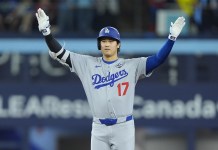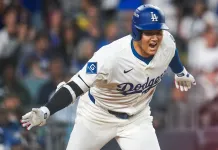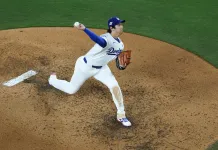The lone punching bag in the NL East has the division’s best player, as the Washington Nationals are in rebuilding mode. They got their World Series rings and went all out to do it, but consistent contention was always going to be challenging with the state of the farm system. Going for a championship comes at a cost, both financially and with the prospects that are used to acquire major league pieces.
En route to losing 97 games last season, the Nationals traded Trea Turner, Max Scherzer, Kyle Schwarber and Daniel Hudson. Keibert Ruiz and Josiah Gray were the focal points of that Turner/Scherzer deal with the Dodgers, and they’ll have a chance to really get their MLB careers started with a team that has extremely low expectations. Teams willing to absorb the financial cost of signing rental free agents have had great success spinning those players for prospects at the trade deadline, which is what the Nationals will look to do with Nelson Cruz, Cesar Hernandez, Steve Cishek, Sean Doolittle and Tyler Clippard. It’s important to recognize these situations, as the Nationals we see now will look a lot different by August.
2022 VSiN MLB Betting Guide
Offense
Punting a season with an elite talent such as Juan Soto is never easy. It might be essential, though. Soto is earning $17.1 million in his arbitration season. He is a Super Two player, so he has a fourth year of arbitration in 2024, but we are looking at the first $450 million contract in MLB history. Mike Trout signed a 12-year, $426.5 million deal with his most recent extension. Soto will get more money than that.
The 23-year-old posted his best full-season wRC %plussign% at 163 in 2021, meaning he was 63% better than league average. Over the last two seasons, Soto has walked 186 times against 121 strikeouts, which is a remarkable achievement in today’s game. He slashed .313/.465/.534, which was a bit of a disappointment, as crazy as that is to say. Soto hit 13 homers in 47 games in 2020 and posted a 201 wRC %plussign% , so he was twice as good as a league-average player. He didn’t follow up that short season with the same power, which leads me to believe it shows up this season.
Of course, teams probably won’t pitch to him much. To start the year, Soto will be protected in the lineup by Cruz and another impending free agent in Josh Bell, but who knows what happens at the deadline. Cruz is still hitting tanks at 41 years old (he hit 32 last year). He’s hit at least 32 homers in every full season since 2014, but 32 was his lowest output since 2013. He hit 16 homers in 53 games in 2020.
Last season marked Cruz’s first with a SLG under .500 since 2012. It wasn’t from a lack of contact quality or barreled balls. I don’t see any deterioration of skills and he hit 13 homers in 55 games with the Rays despite the poor hitting conditions at Tropicana Field. Nationals Park is a launching pad in the summer months, so I’d expect Cruz to do his thing.
%%offer%%
Bell is still a solid hitter, but the Nationals haven’t gotten what they expected out of him. He still hit 27 homers last season and walked more than 11% of the time. He’s a solid offensive player but he wasn’t able to replicate his 2019 season of 37 homers. The top half of this order is really strong with those three power bats plus Hernandez, an OBP machine at the top.
Ruiz has been a league-average bat in 31 games to start his MLB career. He’ll get to take his lumps this season as he grows into being a major-leaguer and learns how to catch a major league pitching staff. He puts a ton of balls in play and should have a lot of chances to drive in runs. If the power uptick shows up, it’ll help the offense a lot.
The rest of the lineup is pretty iffy. Alcides Escobar is a really bad offensive player. Maikel Franco is a buy-low candidate in hopes of a July trade. Victor Robles is not much of a hitter. The bench bats aren’t exciting, either, and there aren’t many helpful prospects down below.
Once the trade winds blow, the Nationals offense is going to look dramatically different. Hernandez, Cruz and Bell are likely to move, among others. Soto will be on an island at that point, unless Ruiz takes a big step forward.
Pitching
The reason why the Nationals will be trade-deadline sellers and why their projections are so low is because of the pitching staff. Stephen Strasburg is still around, but after undergoing thoracic outlet syndrome surgery last summer, he’ll miss the first few weeks of the season. He had a 4.57 ERA with a 5.71 FIP in five starts last season and gave up six runs on eight hits in five innings in 2020. Now 33, his best days look to be behind him, especially after another major surgery.
Patrick Corbin is also still around, but the 2019 season and playoffs took a major toll on him. He got back the velocity he lost in 2020 but still posted a 5.82 ERA with a 5.41 FIP in 171.2 innings. His K% took a nosedive and his HR/FB% skyrocketed. I don’t see any reasons to be optimistic either. He allowed the highest Barrel% of his career and his Hard Hit% the last two seasons has been above 40%. He probably won’t be as bad as a 5.82 ERA, but he may be a league-average pitcher as the de facto ace of the staff.
Gray posted a 5.31 ERA with a 5.71 FIP in his 62.2 innings with the Nationals after the trade from the Dodgers. The 24-year-old only had 39.1 innings in Double-A and 15.2 innings in Triple-A before the deal, so he still has some growing to do. He’s still a high-upside prospect and has good velocity and good swing-and-miss stuff, but he has to learn how to pitch to the game’s best hitters.
Hopefully that happens because the options behind Gray are awful. The Nationals reunited with 38-year-old Anibal Sanchez, who didn’t have an MLB job last season and has had velocity decreases every year since 2013. Erick Fedde outperformed most of his metrics for a while before ending with a 5.47 ERA and a 4.66 FIP. Fedde had a 4.59 ERA in the first half over 64.2 innings before ending the year with a 6.29 ERA in 68.2 innings. His truth lies somewhere in between, but that isn’t very good. Paolo Espino signed in 2007 with the Indians and didn’t make his MLB debut until 2017 with 24 innings. He pitched 109.2 last season for the Nationals with ugly peripherals and a 4.27 ERA.
Most of Washington’s better prospects are in the low levels of the minors, including the pitchers. They have some fringy MLB talent at the Triple-A level, but nothing that represents a huge upgrade.
Along with the likely trades on the offensive side, the bullpen will be torn apart at the deadline if guys are healthy and contributing. The Nationals are going to be running out a lot of guys in their 30s or close to it, and those kinds of bullpens scare me. Not only are those guys higher injury risks, they also have the potential to fall apart due to velocity decreases or normal wear and tear.
Cishek is the best of the bunch with a 3.42 ERA and a 3.74 FIP last season for the Angels. He has a funky delivery and typically runs a high ground-ball split with low home-run rates. He’s also been healthier than guys such as Doolittle and Clippard. Doolittle was a below-average reliever last season and Clippard was limited to 26 appearances.
Kyle Finnegan led the relievers in appearances with 68 and had a nice 3.55 ERA but a 4.52 FIP, with too many walks and too many homers. The other holdovers had lackluster numbers. This is a below-average bullpen and it’s likely to be the worst in baseball after the trade deadline.
Player to Watch
SP Josiah Gray: Gray’s fastball command is the biggest question going into this season. Hitters had virtually no luck on his curveball or slider but slugged .620 against his fastball with 12 home runs out of 40 hits. He had high swing-and-miss rates on the curveball and slider and hitters expanded the zone a lot. He just didn’t locate his fastball. When it got hit, it got hit hard. Fewer than half of Gray’s 0-1 counts became 0-2 counts, as hitters either put a ball in play or he threw a ball on the second pitch. His fastball velocity is above average, but his spin rate is merely average, so it’s unlikely to be a good pitch. The Nationals won’t want to put too much strain on the 24-year-old in his first full MLB season, but we could see some adjustments to his arsenal. If I notice that early in the season, I’ll try to capitalize on that value before his run support gets traded around the league.
Season Outlook
The Braves, Mets and Phillies all have high win totals and high hopes. I also believe the Marlins are better than the market expectation. Somebody has to lose in this division and that somebody will be the Nationals. Offensively, they can compete, but the bottom of the order is a black hole and the pitching staff is awful. We haven’t seen the Nationals develop pitching either. Scherzer was already elite when he got to D.C. and Strasburg had can’t-miss potential. Corbin was a polished product as well and he’s regressed. The Nationals haven’t elevated guys such as Fedde, Austin Voth, Joe Ross and others, so I’m worried about their ability to get a lot out of their arms this season. With a bevy of trades looming, all you can really do is consider the season win total Under here. I think a better play is to wait for an adjusted second-half win total and bet that Under.
Win Total Lean: Under 71.5
Will look for adjusted second-half win total





